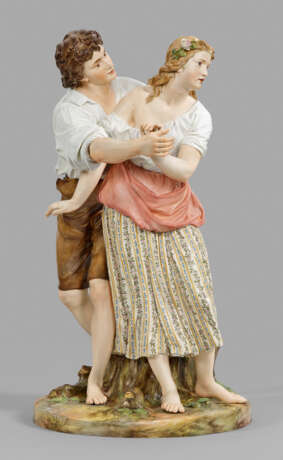ID 1082292
Lot 871 | Große, äußerst seltene Meissen Figurengruppe eines
Estimate value
€ 18 000 – 36 000
Große, äußerst seltene Meissen Figurengruppe eines Liebespaares
Auf naturalistisch staffiertem Sockel stehendes Paar in ländlicher Kleidung. Das Mädchen mit weißer Bluse und apricotfarbener Schürze über gestreiftem, geblümtem Rock, das hellbraune Haar von einem Rosenzweig geschmückt. Hinter ihr stehender, junger Mann in knielanger, brauner Hose und weißem Hemd beim Versuch, sich dem Mädchen zu nähern, während sie sich von ihm abwendet. Polychrome Malerei. Entw. Johann Christian Hirt, 1882. Modell-Nr. M 169. Minim. best./rest.; Schwertermarke. H. 57 cm.
Imposante, monumental anmutende Figurengruppe, entworfen von dem Bildhauer Johann Christian Hirt (1836 Fürth – 1897 München), der ab 1855 an der Akademie in München Klassische Plastik bei Max von Widnmann studierte und später dort ein Atelier betrieb. Bekannt wurde er vor allem durch seine Aufträge von Statuen an öffentlichen Denkmälern und Gebäuden. Unter anderem arbeitete er im Auftrag König Ludwig II., für den er einige Marmorskulpturen zur Ausstattung der Schlösser Linderhof und Herrenchiemsee fertigte. Er schuf einige Kleinplastiken in Bronze und Silber, in denen er die deutsche Sagenwelt und Dichtung sowie die griechische Mythologie thematisierte. Vor allem in seiner frühen Schaffensphase in München lieferte er verschiedenen Statuetten, darunter ein „Haidröslein“ sowie „Hermann und Dorothea“, wobei er sich vermutlich von Gedichten und Epen Johann Wolfgang von Goethes inspirieren ließ. In Goethes „Heidenröslein“ geht es im übertragenen Sinne um einen Jüngling im Liebesrausch beim Versuch, das angebetete Mädchen an sich zu binden, die ihn wiederum abweist.
Die Meissener Manufaktur erwarb 1881 zahlreiche Modelle für Figuren, neben der "Lyrischen Muse" und dem "Schießenden Amor" 1884 den "Parzival" und das "Aschenbrödel".
Vgl. Jedding, Meißener Porzellan, S. 150, Thieme-Becker, XVII, S. 144, Holland/Hyacinth, Allg. Deutsche Biographie 50, 1905, S. 372f.
A large very rare porcelain figure group modelled by J. Chr. Hirt in 1882. Minor chipped/restored. Crossed swords mark.
Meissen. Um 1900.
| Address of auction |
Kunstauktionshaus Schloss Ahlden GmbH Große Str. 1 29691 Ahlden(Aller) Germany | ||||||||||||||
|---|---|---|---|---|---|---|---|---|---|---|---|---|---|---|---|
| Preview |
| ||||||||||||||
| Phone | +49 5164 80100 | ||||||||||||||
| Buyer Premium | 25.0 | ||||||||||||||
| Conditions of purchase | Conditions of purchase | ||||||||||||||
| Business hours | Business hours
|



